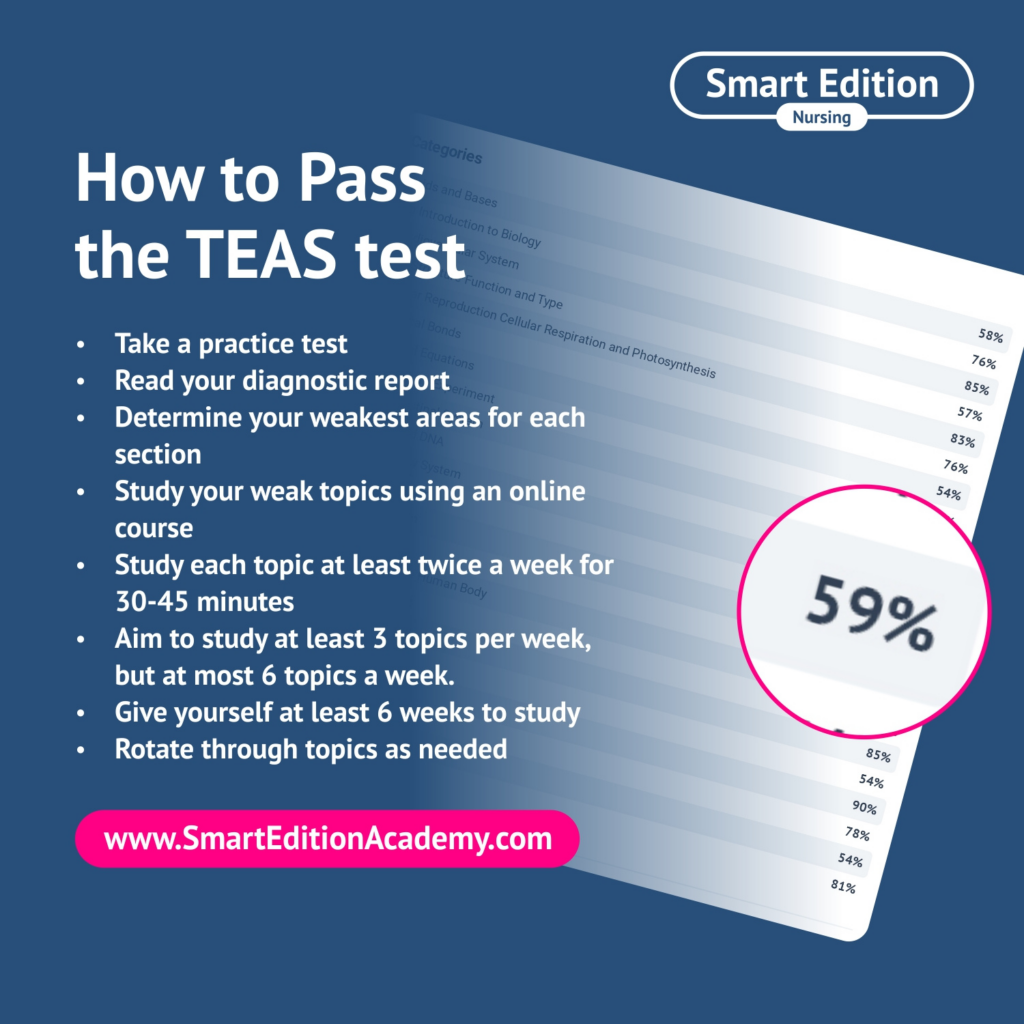Share Blog
How To Study For The TEAS Test
To study for the TEAS test you first must become familiar with the subjects on the test followed by taking a practice test. The next step is to create a study plan and begin studying each topic while continuing to take practice tests.
Studying for this test can be overwhelming, especially if you have no idea where to start. This guide will teach you how to study for the TEAS test.
If you want to go to nursing school, there’s a good chance that you are required to take the ATI TEAS test.
The best way to study for the TEAS test is to take practice tests, focus on studying your weakest subjects and develop an effective study plan to stay focused.
Following these techniques are meant to help you improve your score and increase your chances of getting into your nursing program.
Watch this video to learn more about where to start and how to study for the teas test and of course….how to pass the TEAS test.
How To Pass The TEAS Test
Before anything else, when it comes to how to pass the TEAS test it’s essential first to know how to use a diagnostic practice test.
A diagnostic TEAS practice test determines your strengths and weaknesses, so you know which areas you need to spend more time studying.
It’s best first to assess your current knowledge level to create a benchmark, so you know how to strategize your test preparation methods.
You can start by taking a free ATI TEAS practice test that gives an overview of your test results—the more comprehensive, the better and the better your chance to pass the TEAS test.
This way, you can quickly determine your weakest areas based on your test scores and is generally the best way to answer how to pass the TEAS test.

Pinpoint Your Weakest Areas
After taking a practice test, analyze the test scores to figure out what you still need to know.
Determine two to three specific topics you need to study instead of tackling a subject area in general.
For example, in science, it could be the cardiovascular system, periodic table of elements, and cellular biology.
You will then begin your study sessions with these weakest areas so you can focus on strengthening them.
The ATI TEAS 7 test covers a ton of science questions. It’s more effective to focus on specific topics instead of cramming general subject areas.
Make An Action Plan
After you become equipped with the right set of tools, you can now plan your next steps. Developing an action plan means you have to set specific goals of what you want to achieve.
It’s better if they are measurable so you can quickly check your improvements. An example action plan could be:
- For five days, I will study two topics for two hours each day.
- After retaking the practice test, I want to see a 10% improvement in my test scores.
Set up specific steps towards the intended outcome.
Consistently chart your score every time you take an ATI TEAS practice test to track your improvements as you study along the way.
Understand Your Weaknesses and Why You Have Troubles
If you compared your test scores and saw that you still have not improved, try to evaluate the root cause of your troubles. Sometimes, even if you have studied enough, the reason behind your low test scores could be your test-taking practices.
For example, you may be misunderstanding the questions, but you proceed to answer them anyway. The cause of your troubles could also be careless errors that you can catch if you double-check your answers.
To avoid this, take your time tracking down why you encountered those errors so that you can study more effectively for the next practice test. If you see patterns, evaluate whether they need additional study time or you need to review the test before turning it in.
If you’re having trouble retaining information you can try things like teaching someone else, using mnemonic devices, or writing down what you have learned. You can find learn more about proven study tips to retain information in this article from the Joyce University of Nursing and Health Sciences.

Can You Use A Calculator On The TEAS Test?
You will be able to use a calculator on the TEAS test. A calculator will be provided to you during the test so you do not need to bring your own calculator.
Check out the video below to learn everything you need to know about using the calculator on the TEAS test and how to study for the TEAS test with Brandon Craft and John Wynne from Smart Edition Nursing.
Can I Go Back To A Question On The TEAS Test
You are allowed to go back to a question on the TEAS test and by flagging the question during the test. You can only go back to a question during your current test section. Once you have completed a section you can not go back and change your answer.
Find The Best TEAS Prep Study Resources
Now that you know the specific topics you need to study, it’s time to really answer the question of how to study for the teas test. First determine the required resources to help you practice your weakest areas. There are many types of study materials to choose from. You can watch study videos, read study guides, or practice with flashcards, or study with the best TEAS prep course.
It’s easier to choose the resources that work best for you if you know your learning style. A learning style is your preferred way of processing information. You can be a visual, audiovisual, verbal, or social learner.
Recent research on learning styles by the King Saud Bin Abdulaziz University for Health Sciences has shown “The students demonstrated a range of learning style preferences. The most frequently preferred style was the auditory learning style, followed by the kinaesthetic and individual learning styles. The least preferred style was group learning. The relationship between learning style and GPA was only positive with the individual learning style and negative with the group learning style.”
This research indicates that when you lean in your preferred learning style your studying and retention will improve.
For example, if you think you are a social learner, you might retain information faster if you teach the source material to another person. You can also be an audiovisual learner where you prefer to see what you’re studying and hear a narration simultaneously.

Now that you have a better idea of how to pass the TEAS test take a few minutes to review what is on each section of the test, you can start with the TEAS English review and if you plan to take the test from home learn everything you need to know about taking the TEAS test from home.

Melissa Wynne
Pediatric Nurse Practitioner Founder Smart Edition Nursing
Melissa founded Smart Edition Nursing in 2018. She has a bachelors and masters degree in nursing from Northeastern University in Boston. Melissa is a Pediatric Nurse Practitioner at Gulf Stream School in Gulf Stream Florida.